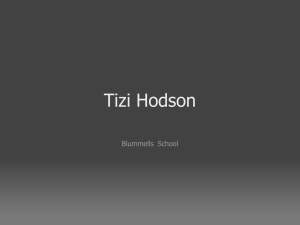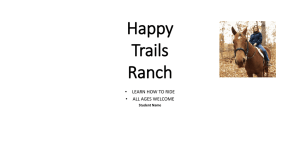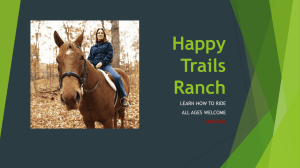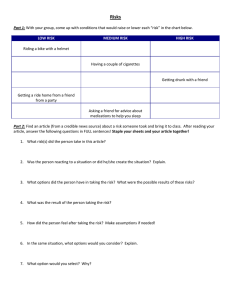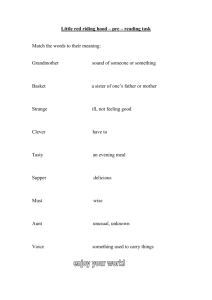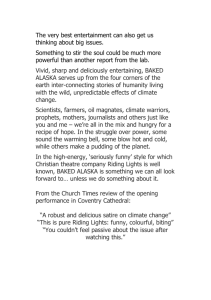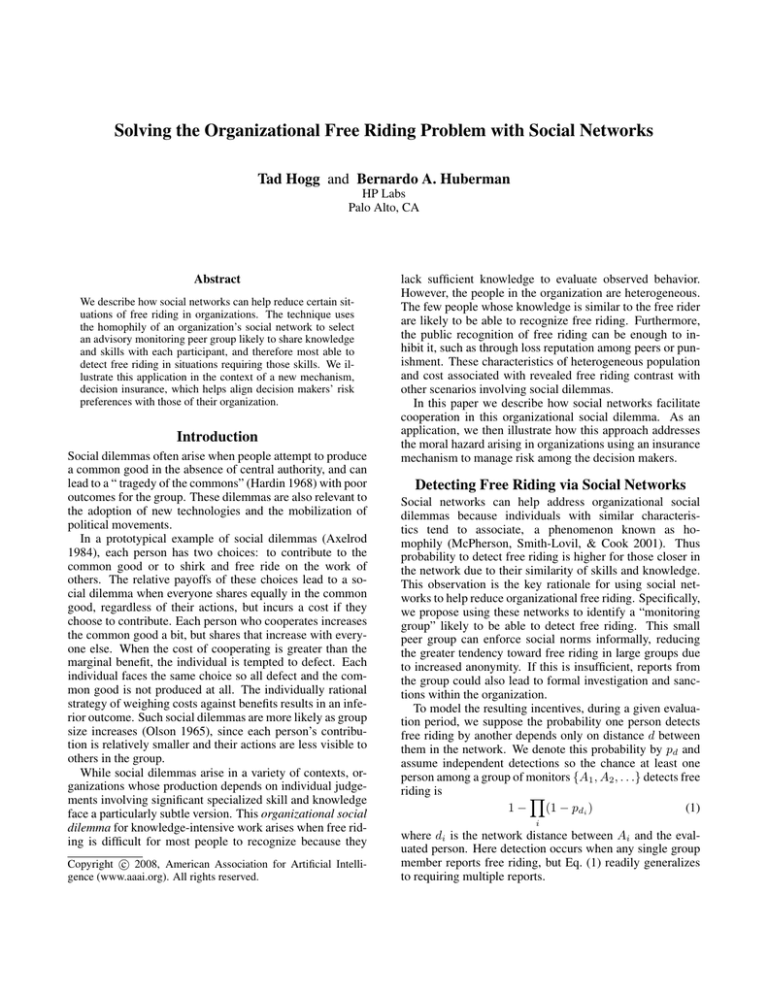
Solving the Organizational Free Riding Problem with Social Networks
Tad Hogg and Bernardo A. Huberman
HP Labs
Palo Alto, CA
Abstract
We describe how social networks can help reduce certain situations of free riding in organizations. The technique uses
the homophily of an organization’s social network to select
an advisory monitoring peer group likely to share knowledge
and skills with each participant, and therefore most able to
detect free riding in situations requiring those skills. We illustrate this application in the context of a new mechanism,
decision insurance, which helps align decision makers’ risk
preferences with those of their organization.
Introduction
Social dilemmas often arise when people attempt to produce
a common good in the absence of central authority, and can
lead to a “ tragedy of the commons” (Hardin 1968) with poor
outcomes for the group. These dilemmas are also relevant to
the adoption of new technologies and the mobilization of
political movements.
In a prototypical example of social dilemmas (Axelrod
1984), each person has two choices: to contribute to the
common good or to shirk and free ride on the work of
others. The relative payoffs of these choices lead to a social dilemma when everyone shares equally in the common
good, regardless of their actions, but incurs a cost if they
choose to contribute. Each person who cooperates increases
the common good a bit, but shares that increase with everyone else. When the cost of cooperating is greater than the
marginal benefit, the individual is tempted to defect. Each
individual faces the same choice so all defect and the common good is not produced at all. The individually rational
strategy of weighing costs against benefits results in an inferior outcome. Such social dilemmas are more likely as group
size increases (Olson 1965), since each person’s contribution is relatively smaller and their actions are less visible to
others in the group.
While social dilemmas arise in a variety of contexts, organizations whose production depends on individual judgements involving significant specialized skill and knowledge
face a particularly subtle version. This organizational social
dilemma for knowledge-intensive work arises when free riding is difficult for most people to recognize because they
c 2008, American Association for Artificial IntelliCopyright °
gence (www.aaai.org). All rights reserved.
lack sufficient knowledge to evaluate observed behavior.
However, the people in the organization are heterogeneous.
The few people whose knowledge is similar to the free rider
are likely to be able to recognize free riding. Furthermore,
the public recognition of free riding can be enough to inhibit it, such as through loss reputation among peers or punishment. These characteristics of heterogeneous population
and cost associated with revealed free riding contrast with
other scenarios involving social dilemmas.
In this paper we describe how social networks facilitate
cooperation in this organizational social dilemma. As an
application, we then illustrate how this approach addresses
the moral hazard arising in organizations using an insurance
mechanism to manage risk among the decision makers.
Detecting Free Riding via Social Networks
Social networks can help address organizational social
dilemmas because individuals with similar characteristics tend to associate, a phenomenon known as homophily (McPherson, Smith-Lovil, & Cook 2001). Thus
probability to detect free riding is higher for those closer in
the network due to their similarity of skills and knowledge.
This observation is the key rationale for using social networks to help reduce organizational free riding. Specifically,
we propose using these networks to identify a “monitoring
group” likely to be able to detect free riding. This small
peer group can enforce social norms informally, reducing
the greater tendency toward free riding in large groups due
to increased anonymity. If this is insufficient, reports from
the group could also lead to formal investigation and sanctions within the organization.
To model the resulting incentives, during a given evaluation period, we suppose the probability one person detects
free riding by another depends only on distance d between
them in the network. We denote this probability by pd and
assume independent detections so the chance at least one
person among a group of monitors {A1 , A2 , . . .} detects free
riding is
Y
1 − (1 − pdi )
(1)
i
where di is the network distance between Ai and the evaluated person. Here detection occurs when any single group
member reports free riding, but Eq. (1) readily generalizes
to requiring multiple reports.
pd = αd−β
(2)
Here α, between 0 and 1, is the probability an immediate
neighbor detects free riding and β characterizes the decreasing probability with distance in the network, so β > 0, with
typical observed values for power laws in network correlations having β ranging between 1 and 3.
In practice, the available social network used to select
monitors will not exactly match the actual network in the
group. Instead the network data is only an approximation of
people’s relationships, preferences and knowledge of each
other. Thus the network used in the mechanism could be
incomplete, noisy or out of date. A significant question for
using social networks to reduce free riding is the extent to
which the required incentive structure is affected by such
lack of knowledge.
As an initial step toward addressing this question, we consider a sample of people with multiple known networks,
each with differing link semantics and degree of homophily.
Treating one of these networks as correctly indicating the
ability to detect free riding, according to Eq. (2), then allows
using the other networks, or deliberately degraded versions
of the networks, as example noisy networks available to the
mechanism. One such sample arises from the networks created by users of Essembly1 , which allows members to vote
on various ideological issues. The site offers both a social
network (FRIENDS) and two ideological networks (ALLIES
and NEMESES). These networks enable users to distinguish
between their friends and people on the site whom they tend
to agree (or disagree) with but may not know personally.
Users form these networks explicitly and each link must be
approved by both users involved in that link.
Our data set consists of fully anonymized network connections (i.e., friends, allies and nemeses) as of December
12, 2006. There are 15,092 unique registered users who
voted, and 5,028 of them have declared friends, allies, or
nemeses. The networks differ in their links, e.g., less than
a third of neighbors in the FRIENDS network are also neighbors in the ALLIES network, and vice versa. Nevertheless,
the networks are somewhat correlated in that, say, a friend is
more likely to be an ally than is a random other user. For this
paper, we use these networks only as examples of networks
explicitly created by users, with different nominal meanings
for the links. Essembly voting itself does not include the risk
and payoff aspects of social dilemmas, and in particular is
not a community with free riding. Nevertheless, the Essembly networks can illustrate the effects of using incomplete
knowledge of a social network in the context of a model of
free riding detection given in Eq. (2).
Specifically, we suppose the social network in Essembly (the FRIENDS network) gives the graph structure defining likelihood of detection, i.e., determining the distance in
Eq. (2) for each pair of people. As the organizational group
1
Essembly LLC at www.essembly.com
Pdetect
Many observed correlations in behavior and preferences
in social networks decrease as a power law. As a specific
example, we take pd to have a power law form:
0.8
0.7
0.6
0.5
0.4
0.3
0.2
1
2
3
Β
Figure 1: Detection probability Eq. (1) for the Essembly
networks among the top 100 users as a function of β with
α = 0.5 using monitoring groups of size 5 from among
those users. Curves from top to bottom are for monitors
determined from full knowledge of the FRIENDS network
(black), just half the links in the that network averaged over
100 randomly selected subgraphs (dashed, black), the AL LIES network (dashed, gray) and by random selection (gray).
G we use the 100 most active users in our dataset. We consider four approaches to selecting a monitoring group of size
m = 5 for each person u:
1. select the m closest people to u in the FRIENDS network
2. select the m closest people to u in the ALLIES network
3. select the m closest people to u in a partially observed
version of the FRIENDS network
4. select m people randomly
in all cases selecting the monitors from among the members of the group G other than the person u. These selection
methods compare performance without benefit of social network information (random selection), using full knowledge
of the relevant network and two types of noise in applying social networks: 1) the available network is correlated
with the relevant network, but formed with different intent
in the links (in this case reflecting commonality of behavior in terms of voting preferences rather than any necessary
implication that linked people personally know each other),
and 2) the available information is incomplete because people have not explicitly made their links known to the system.
Fig. 1 compares these methods. As one would expect, using the network whose distances correspond directly to the
ability of people to detect free riding gives the best performance. Performance degrades with noise, but the assumed
network provides a useful monitoring group as long as its
links have reasonable correlation with monitoring ability.
Thus, at least for these networks, the properties needed for
detecting free riding degrade gracefully with the types of
noise likely to occur in available networks.
Managing Risk in Organizations
In this section, we present an example of using social networks to reduce organizational free riding that could be in-
troduced by a new mechanism for managing risk attitudes
among decision makers. Due to its emphasis on detailed
risk assessments, this mechanism is well-suited to using the
homophily properties of social networks.
While most organizations consider taking risks essential for success, few have policies to encourage appropriate risk taking by their employees. Instead organizations
often reward outcomes, not decisions, which inhibits risk
taking by risk averse decision makers. Moreover, the negative connotation associated with gambling (March 1994;
March & Shapira 1987) makes risky choices that fail appear to be mistakes that could be avoided. Additional difficulties arise from how individuals act when confronted
with risk (Kahneman & Lovallo 1993), misperceptions
of randomness (Waggenar 1972) and aversion to ambiguity (Camerer & Weber 1992). Furthermore, risky alternatives suffer from framing issues: people tend to be risk
averse with formulations emphasizing positive outcomes,
but risk seeking when emphasizing poor outcomes (Kahneman & Tversky 1979). In practice, managers often focus
on the value of the outcome rather than weighing the value
by its probability (Shapira 1995; B. Fischhoff & Hope 1984;
Douglas 1990). Moreover, managers often do not understand or trust probabilistic measures (Slovic 1967; Fischhoff
et al. 1981; Slovic 1987), and are often reluctant to change
behavior because of status quo biases (Samuelson & Zeckhauser 1988; Denrell & March 2001). This mismatch in
risk preferences between individuals and organizations motivates mechanisms to encourage risk averse managers to
make decisions based on their assessment of the best interest
of the enterprise.
Insurance is a common approach to risk, by spreading the
risk over a large group. This mechanism allows risk averse
individuals to trade an uncertain but possibly large loss for
a certain but smaller loss (the premium). Insurance works
well when the number of insured people is large, their risks
are not highly correlated and sufficient experience with the
risks enables setting appropriate premiums.
Several economists suggest extending insurance to a variety of risky endeavors that are difficult for individuals to
insure against. Examples include consumption-indexed public pension funds (Merton 1983), options on business cycle
variables such as consumer confidence indices (J. F. Marshall & Tucker 1992), and insurance for the choice of a
professional career (“career insurance”) and volatile property values (Shiller 2003). Potentially, such insurance could
improve economic performance by encouraging individual
choices that would benefit society as a whole, on average,
but are too risky individually. While provocative, these proposals are difficult to implement because they require finding groups willing to assume these risks and gaining enough
experience in assessing risk and setting premiums.
As with other insurance, these proposals must also contend with two key challenges. The first challenge is moral
hazard: the tendency to change behavior once insured so the
insured outcome becomes more probable. The second challenge is adverse selection: those seeking insurance tend to
be those with higher than average risk but this increased risk
is not apparent to the insurer.
Decision Insurance
Within organizations, managers should choose projects with
the highest expected value for the company. However, when
managers believe risky projects have a higher expected value
than less risky alternatives, risk averse managers will be reluctant to take the risk when their performance is largely
evaluated by success of the projects they select to undertake. Decision insurance allows managers to transfer some
of this risk to the organization by paying a premium in exchange for a payoff from the group’s profits if the project
fails. Decision insurance can adjust for variation in risk attitudes among people by having different combinations of
pay for performance and profit sharing for different managers, which amounts to having different insurance premiums. This flexibility, as well as senior managers’ ability
to decide who participates, helps address adverse selection.
Decision insurance can also be viewed as a form of profit
sharing, a perspective likely to be more familiar to participants than insurance.
Decision insurance has several aspects:
• scope: Identify the relevant decisions and outcomes, and
quantify the timing and objective success measures. The
outcomes could occur at different times. This process is
similar to scoping other information-based mechanisms
to aid decision making (Hahn & Tetlock 2006).
• group: Identify the participants, i.e., those managers who
make the decisions and decide who should participate in
the decision insurance, e.g., whether the insurance should
be voluntary or a mandatory form of profit sharing for
every decision maker in the group.
• social network: Find the community of practice for each
of those insured, using available social networks within
the organization as described below. These communities
form the monitoring groups for the insured.
• parameters: Set appropriate threshold values, premiums
and payouts based on the senior managers’ assessment of
the value of the different projects.
• operation: The organization collects the premiums and
pays out the amount of insurance to those whose projects
failed at the end of each insurance period.
Setting payouts and premiums depends on the nature of
the decisions. For example, if the value of success is widely
known (e.g., bidding on a government contract with specified value) but the probability of success is not known (e.g.,
due to potential bids from competitors), the manager evaluating whether this project is worthwhile for the organization (i.e., has high expected value) would need to devote resources to better estimating the probability of success and
evaluating how to increase that probability. In this situation,
the known value could form the basis for the insurance payout in case of failure. If, on the other hand, the value to the
organization must be estimated as part of the decision process, then senior managers setting insurance payouts would
have to use less specific information, e.g., the values of similar projects in the past. The overall scale for the payouts can
vary dynamically with the profitability of the organization as
a whole. This makes the mechanism suited to organizations
1
prob. to detect free riding
ideal risk
neutral
with decision
insurance
no insurance
risky
safe
free ride
0
0
1
ratio of risky to safe expected payoffs
Figure 2: Schematic behavior regimes for selection among
a safe project, a risky one and free riding. The dashed curve
shows the ideal behavior: switching between safe and risky
projects based on which has the higher expected value. Risk
averse managers require a larger expected value to overcome
the risk when there is no insurance (gray line). Decision insurance shifts preferences closer to the ideal, but could instead lead to free riding if detection probability is too low
(black lines). The free riding regime applies only to the case
of decision insurance, representing the effects of the moral
hazard introduced by the insurance.
performing many independent risky projects, so the relative
variance in performance for the organization is smaller than
for individuals.
The mechanism’s operation must be credible to participants. For example, to encourage more risk taking the insurance payouts on failure should not be just a prelude to other
sanctions, such as loss of status or even employment.
Fig. 2 schematically illustrates choices when a manager
selects between a safe and a risky project. Ideally, the manager would pick the project with the highest expected value
after evaluating the alternatives. Without insurance, risk
averse managers tend to favor the safe project, even when
they believe its expected value is less than the risky one. Decision insurance improves this situation by having the managers act closer to risk-neutral decision makers, but may also
lead to free riding where managers do not give full effort
in evaluating their choices. Details of the boundaries between these regimes, which could differ among people in
the group, depend on the decision makers’ risk attitudes and
the payoffs of the various projects.
Moral Hazard and Community of Practice
With decision insurance, moral hazard arises through the effort managers exert in evaluating the success likelihood or
value of potential projects. With compensation no longer
tied primarily to the success of the individual’s efforts, there
is a temptation to work less and suffer only a small decrease
in individual compensation as a share in the lowered profits
of the organization. Even if group members don’t actually
free ride, the appearance of a conflict of interest caused by
insurance could inhibit its widespread adoption.
Free riding is conventionally addressed through monitoring or reputation. Managers in an organization provide some
performance monitoring. However especially in the context
of knowledge work, senior managers may lack the time or
detailed expertise to know whether projects’ expected values are accurately estimated through extensive application
of a decision-maker’s expertise and familiarity with the situation.
To discourage free riding, we propose supplementing
manager oversight with a peer group of coworkers likely
to be familiar with the decision maker’s choices2 . Specifically each member of the group assesses whether the manager is free riding in the context of a decision making event.
If the number of group members reporting free riding exceeds a threshold value, then senior management can decide
to investigate and, if appropriate, impose a penalty on the
decision maker. This penalty could take the form of an increased decision insurance premium or other organizational
sanction.
The monitoring group size and investigation threshold
should balance the need to deter free riding against the possibility of false positives, which would tend to make people hesitate to take risky projects. That is, peer monitoring
may encourage people to behave as they expect the majority of the group thinks is appropriate. This would counteract the benefit of the insurance when the majority is more
risk averse than the insured or group members have significantly less ability to evaluate the decisions. Thus although
the monitoring group can reduce free riding, care must be
taken that it does not adversely affect the decision making
of the insured.
Ideally, the threshold should be large enough to avoid
false positives, while still having a reasonable chance of detecting free riding when it occurs. Such a choice ensures
the formal investigation is rarely exercised while the group’s
mere existence and the insured’s desire to maintain reputation among the peer group discourages free riding.
Whether this ideal situation is possible depends on the
ability of group members to identify free riding. Thus a
key aspect of avoiding free riding among decision makers
with specialized skills and knowledge is finding a suitable
monitoring group. As we describe in the remainder of this
section, available social networks provide one approach to
identifying a suitable group for each insured decision maker.
Establishing an effective monitoring group requires identifying coworkers familiar with both with the manager and
the nature of the decisions. This can be challenging in
rapidly changing organizations or projects. Fortunately,
those belonging to the manager’s community of practice often share both skills and relevant knowledge so are likely
to be able to evaluate decision quality as distinct from just
observing the eventual outcomes of the decisions. Thus an
obvious strategy is to determine those communities of practice from available information on the social network inside
2
This group is reminiscent of the so-called friendly societies
that were common prior to modern insurance companies and in
which people of similar social background provided mutual support while being able to monitor for free riding.
the organization.
The advent of electronic communications offers a unique
opportunity to observe the flow of information along both
formal and informal channels. For example, email exchange is an indicator of collaboration and knowledge exchange (Huberman & Adamic 2004). This volume of data
enables the discovery of shared interests and relationships
where none were previously known, as well as ways to automatically identify communities of practice from the social
network of an organization (Tyler, Wilkinson, & Huberman
2003; Wu & Huberman 2004; Schwartz & Wood 1993).
The monitoring group can have explicit directions to evaluate the decision-maker. However people in the group, as
members of the organization, also have direct incentives to
ensure no one free rides. This incentive arises from their
profit sharing based on the organization’s performance, so
they face a loss if others free ride. Thus members of the
monitoring group have both incentives for monitoring and
the ability to evaluate decisions due to their commonalities
with the decision maker.
Moreover, in contexts where free riding may occur, people can prefer to join organizations with monitoring groups
to help enforce social norms of productive behavior (Gurerk & others 2006). The expectation monitoring encourages
greater overall performance can more than compensate for
perceived intrusiveness of the groups and the time required
to participate in the monitoring groups. Thus, such uses of
social networks can encourage positive self-selection and reduce situations in which the monitors would need to act.
Discussion
In this paper we proposed organizations use available social networks to reduce free riding, thereby enabling their
use of economic mechanisms that would otherwise be rejected due to fear of free riding. We described one such
mechanism: decision insurance. Decision insurance offers a
flexible mechanism for tackling the vexing problem of making decision makers less risk averse in situations where the
expected return on some risky projects is higher than that
of safer ones, but senior managers lack the time or detailed
knowledge to evaluate those projects themselves (in which
case they could simply specify which projects their organizations should work on).
To reduce free riding incentives, social networks allow
more fine-grained monitor selection than just using the closest individuals. For instance, if people are reluctant to critique friends or more likely to collude with them, even if that
reduces their profit sharing, the selection of the monitoring
group could be restricted to avoid direct neighbors, with perhaps some loss in ability to detect free riding. As another
example, social networks allow individually adjusting the
mechanism based on position in social network, e.g., lower
insurance premium for those in more highly connected regions of the network since they are less likely to avoid detection of free riding. Such adjustment has the further benefit of
encouraging people to reveal social network information but
also could tempt them to collude with others to reveal links
only to those who agree to give them good ratings. Thus using social networks within a mechanism makes most sense
when spoofing the network is relatively costly, e.g., by having the mechanism rely on more distant members of the network than just immediate neighbors, forcing a larger group
to collude, and using revealed activities – such as exchanged
emails or edits to shared files – that are costly to spoof (i.e.,
more than just agreeing with someone else to put a link to
them in a database). Alternatively, the mechanism could include incentives to reveal the strength of links by having
payout partially dependent on how well a person can predict behavior of people they link to, as previously proposed
for unstructured groups (Chen, Fine, & Huberman 2004;
Prelec 2004).
An advantage of using communities of practice for monitoring decision makers is that these communities tend to
restructure more quickly than the formal organization when
confronted with new constraints or opportunities (Huberman
& Hogg 1995). One common change is turnover in organizations leading to new people continually joining the group
of decision makers. Newcomers will require some time to
establish a formal track record for accessing premiums, but
informal networks for newcomers within the group are often established more rapidly. Thus an interesting question is
how the response of the communities depend on the nature
of the social network (Huberman & Adamic 2004).
Beyond its use for reducing free riding, the monitoring
group could be a proactive aid to the decision maker, as
an informally identified group of people who likely have
relevant knowledge. Hence the identified group could participate in additional mechanisms of aggregating information (Chen, Fine, & Huberman 2001; Hahn & Tetlock 2006)
relevant for the manager.
Using social networks is particularly useful for informal
organizations, where a peer group can not be readily estimated from the formal organization structure. These situations include extensive subcontracting or outsourcing where
the people involved in any particular formal organization
may change rapidly. Thus adding social networks to economic mechanisms could facilitate a broader range of organizational structures.
Our discussion of decision insurance using social networks leads to two empirical questions for future work: how
well does insurance alter actual risk behaviors in the context
of business decisions, and how to select appropriate parameters to instantiate the mechanism in particular organizations.
For instance, laboratory experiments could study controlled
decision settings. Initial decision insurance implementations
will likely require relatively short times for measurable returns, so people can gain confidence in the mechanism. One
approach to estimate appropriate parameters for decision insurance insurance is through various pilot programs with
different choices. Observing the resulting participation can
give some indication of the appropriate choices, as well as
collecting the necessary information on the track records of
managers to set premiums. To some extent, this process
could be self-organizing as people choose to be part of an
organization they feel will likely perform well. Once organizations gain experience with decision insurance, it could
be extended to longer time horizons, perhaps using more sophisticated tools such as tradeable futures and options simi-
lar to those in financial markets.
Successful examples within organizations would give
confidence and experience to extend such insurance mechanisms more broadly (Shiller 2003). Outside the enterprise
moral hazard is more severe since there is no formal monitoring structure such as managers. Nevertheless, informal
peer groups, not part of a formal business, can reduce moral
hazard. An example is microlending institutions in the third
world. In some cases (Grieco 1998) the group of potential
loan recipients has both the incentive and the knowledge to
reduce moral hazard, since the prospect of future loans depends on the repayment history of the group as well as how
they use the loan.
Available social networks can be useful in planning targeted marketing via word of mouth (Domingos & Richardson 2001), improving collaborative filtering (Lam 2004),
and enhancing online reputation mechanisms (Hogg &
Adamic 2004). Reducing moral hazard in decision insurance is a further example of how social networks can improve economic mechanisms. Thus the growing availability
of social networks provides numerous opportunities for facilitating a variety of novel economic mechanisms.
Acknowledgements
We thank Michael Brzozowski for analysis of the Essembly data
and Chris Chan and Jimmy Kittiyachavalit of Essembly for their
help in providing the data. We have also benefited from discussions
with Kay-Yut Chen and Murat Kaya.
References
Axelrod, R. 1984. The Evolution of Cooperation. NY: Basic
Books.
B. Fischhoff, S. R. W., and Hope, C. 1984. Defining risk. Policy
Science 17:123–139.
Camerer, C., and Weber, M. 1992. Recent developments in modeling preferences: Uncertainty and ambiguity. J. of Risk and Uncertainty 5:325–370.
Chen, K.-Y.; Fine, L. R.; and Huberman, B. A. 2001. Forecasting uncertain events with small groups. In Proc. of the 3rd ACM
Conference on E-commerce, 58–64.
Chen, K.-Y.; Fine, L. R.; and Huberman, B. A. 2004. Eliminating
public knowledge biases in information-aggregation mechanisms.
Management Science 50:983–994.
Denrell, J., and March, J. 2001. Adaptation as information restriction: the hot stove effect. Organization Science 12:523–538.
Domingos, P., and Richardson, M. 2001. Mining the network
value of customers. In Proc. of the 7th ACM SIGKDD Conference
on Knowledge Discovery and Data Mining, 57–66. ACM Press.
Douglas, M. 1990. Risk as a forensic resource. Daedalus 119:1–
16.
Fischhoff, B.; Lichtenstein, S.; Slovic, P.; Derby, S. L.; and
Keeny, R. 1981. Acceptable Risk. Cambridge: Cambridge University Press.
Grieco, M. 1998. Microfinance and the social exclusion agenda.
In Accounting SIG. Buisness School, Univ. of North London.
Gurerk, O., et al. 2006. The competitive advantage of sanctioning
institutions. Science 312:108–111.
Hahn, R. W., and Tetlock, P. C., eds. 2006. Information Markets:
A New Way of Making Decisions. Washington DC: AEI Press.
Hardin, G. 1968. The tragedy of the commons. Science 162:1243.
Hogg, T., and Adamic, L. 2004. Enhancing reputation mechanisms via online social networks. In Proc. of the 5th ACM Conference on Electronic Commerce (EC’04), 236–237. ACM Press.
Huberman, B. A., and Adamic, L. A. 2004. Information dynamics
in the networked world. In Ben-Naim, E.; Frauenfelder, H.; and
Toroczkai, Z., eds., Complex Networks. Springer. 371–395.
Huberman, B. A., and Hogg, T. 1995. Communities of practice: Performance and evolution. Computational and Mathematical Organization Theory 1:73–92.
J. F. Marshall, V. Bansal, A. F. H., and Tucker, A. L. 1992. Hedging business cycle risk with macro swaps and option. Continental
Bank Journal of Applied Corporate Finance 4:103–108.
Kahneman, D., and Lovallo, D. 1993. Timid choices and bold
forecasts: a cognitive perspective on risk taking. Management
Science 39:17–31.
Kahneman, D., and Tversky, A. 1979. Prospect theory: An analysis of decision under risk. Econometrica 47(2):263–292.
Lam, C. 2004. SNACK: incorporating social network information in automated collaborative filtering. In Proc. of the 5th ACM
Conference on Electronic Commerce (EC’04), 254–255. ACM
Press.
March, J., and Shapira, Z. 1987. Managerial perspectives on risk
and risk taking. Management Science 33:1404–1418.
March, J. 1994. A Primer on Decision Making. New York: The
Free Press.
McPherson, M.; Smith-Lovil, L.; and Cook, J. M. 2001. Birds
of a feather: Homophily in social networks. Annual Review of
Sociology 27:415–444.
Merton, R. C. 1983. On Consumption-Indexed Public Pension
Funds. National Bureau of Economic Research. University of
Chicago Press.
Olson, M. 1965. The Logic of Collective Action: Public Goods
and the Theory of Groups. Harvard Univ. Press.
Prelec, D. 2004. A Bayesian truth serum for subjective data.
Science 306:462–466.
Samuelson, W., and Zeckhauser, R. J. 1988. Status quo bias in
decision making. Journal of Risk and Uncertainty 1:17–59.
Schwartz, M. F., and Wood, D. C. M. 1993. Discovering shared
interests among people using graph analysis. Communications of
the ACM 36(8):78–89.
Shapira, Z. 1995. Risk Taking: a Managerial Perspective. Russell
Sage Foundation.
Shiller, R. J. 2003. The New Financial Order: Risk in the 21st
Century. Princeton University Press.
Slovic, P. 1967. The relative influence of probabilities and payoffs
upon perceived risk of a gamble. Psychonomic Science 9:223–
224.
Slovic, P. 1987. Perception of risk. Science 236:280–285.
Tyler, J.; Wilkinson, D.; and Huberman, B. A. 2003. Email
as spectroscopy: Automated discovery of community structure
within organizations. In Huysman, M.; Wegner, E.; and Wulf, V.,
eds., Communities and Technologies. Kluwer Academic.
Waggenar, W. 1972. Generation of random sequences by human
subjects: a critical review of the literature. Psychological Bulletin
7:65–72.
Wu, F., and Huberman, B. A. 2004. Finding communities in linear
time: a physics approach. European Physics Journal B38:331–
338.

